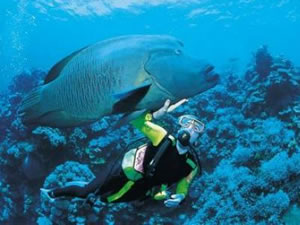
Current species losses comparable to dinosaurs extinction
Current species losses comparable to dinosaurs extinction

Australian scientists have announced a major new finding that helps explain how natural systems like coral reefs and forests maintain the richness of their mix of species.
Their findings have important implications for understanding how humans can better protect biodiversity during one of the worst episodes of species extinction in the Earth’s history.
The research also may help to explain why, in habitats fragmented by human activity, the loss of species can be especially high – despite our best attempts at conservation.
Mathematical modelling by a team from the ARC Centre of Excellence for Coral Reef Studies and James Cook University, published today in the prestigious journal Ecology Letters, identifies the way species disperse across fragmented habitats as one of the keys to biodiversity – and how to preserve it.
'One of the great unanswered questions in ecology for the past 80 years is how species-rich communities like reefs and rainforests maintain their diversity. When resources are limited, you’d expect that the most competitive species would eventually dominate and the others be wiped out,' says lead author Mr Yacov Salomon, now a PhD candidate at the University of Melbourne.
Till now, explanations have focused on what goes on in the habitats themselves. However, in their latest paper, the team argues that the answer lies also in how corals and rainforests spread their offspring across surrounding fragments of available habitat. By dispersing offspring unevenly – on winds, current or carried by other creatures – across patchworks of reefs or forest fragments, the richness of biodiversity is perpetuated.
'We’re basically proposing a novel mechanism by which biodiversity can be maintained, which helps to explain how some of our most marvellous natural systems retain their richness.
'For example, for every reef that receives plenty of offspring from dominant coral types floating in on the current, there will be other reefs that receive fewer offspring from those corals – giving the less competitive species an opportunity to thrive.'
The new theory may also help explain why native bush surrounding Australia’s cities and farms also tends to lose species over time, as growing human impacts further fragment the habitat that helps protect biodiversity and disrupt the process of dispersal of their seeds and offspring.
'There is a practical angle to this idea,' says Professor Sean Connolly, a co-author of the study. 'The take-home message from a conservation standpoint is that losing fragmented habitats is likely to result in greater loss of species than you might otherwise expect.
'The models that scientists currently use to predict biodiversity loss focus on the overall reduction in dispersal between increasingly far-flung habitats. Our study shows that fragmentation also reduces the opportunities for different species to have different dispersal patterns.
'That can mean a double whammy for species that aren’t good competitors: less success dispersing offspring into suitable habitat, and fewer habitats that offer some respite from competitively dominant species.'
'On the flip side, though, it also means that restoring degraded patches of habitat may have greater beneficial effects on biodiversity than we previously thought.'
'The bottom line is that, if your aim is to maintain a rich community of species, like on coral reefs or in rainforests, real-world complexities in dispersal need to be considered.'
According to Mr Salomon, 'Until now, researchers didn’t consider complex dispersal patterns as something that could help explain biodiversity. Our study shows that it can be quite important. That’s what science uses mathematical models for: to uncover the universe of the possible.'
'The next step is to go out and measure how species that compete for scarce resources in nature differ in their dispersal. Those measurements will help us understand just how important this new mechanism is in particular ecosystems, like on the Great Barrier Reef.'
Prof. Connolly says there is a growing consensus that the loss of species worldwide has reached such a pitch it is now comparable to the great mass extinctions of species which occurred in the Earth’s past, the best-known example being the disappearance of the dinosaurs.
'This underlines the importance of finding ways to protect biodiversity as a whole in complex biological systems, like reefs and forests, not just one species at a time' he says.
The paper 'Effects of asymmetric dispersal on the coexistence of competing species' by Yacov Salomon, Sean Connolly and Lance Bode appears in the current issue of Ecology Letters online.